The Galapagos Islands are unique amongst other islands around the world, wildlife and its behaviour make the Galapagos Islands an attraction for scientists and nature lovers. Gracious blue footed boobies and the endemic giant tortoises, sea lions, mysterious islands creatures like birds that lost their ability to fly (flightless cormorants), penguins at the equator, armies of marine iguanas and other species, endemic to the Galapagos islands help us learn how friendly animals can be when not threatened. Come and learn to live in harmony with nature at the Galapagos islands.
In middle of wildlife and eternal calm of the islands, white, red, olive and black sand beaches invite to admire and lie down. The geography of the Galapagos islands is as fascinating as its inhabitants, islands merge into volcanoes that disappear under water, the Galapagos islands archipelago is an oasis for animals and plants that exist nowhere else.
The rich Galapagos islands marine life is fascinating, a world as wonderful as on the islands, colourful fish in schools, manta rays, sea turtles, hammer head sharks, whale sharks, and magnificent reefs.
The Galapagos Islands are at the equator line, 970 km. (600 miles) west of mainland Ecuador. The Galapagos Islands are a group of thirteen main islands, six smaller islands, tiny islets and rocks covering an area of 8000 sq. Km (3090 sq. miles). Each of the islands has more than one name, four islands in the Galapagos park have inhabitted areas. 3% of the Galapagos Islands area is open to tourism. The rest of the Galapagos islands park is protected areas.

Galapagos islands airport.

A moonlike panorama makes it unique among other islands of the Galapagos archipelago. After a dry landing, a 600 meter visitor’s path takes you to the islands 114 mt. summit where the most dramatic view of the Galapagos islands look onto Sullivan Bay(Santiago island) and Pinnacle Rock. You can find the Galapagos Penguin (Speeniscus Mendiculus) between January and March, and the marine tortoises that come to nest on the sandy beaches.

Chinese Hat is a crazy little island looking just like a Chinese hat in the islands. It’s right off the southeastern tip of Santiago island. Galapagos islands snorkeling is fantastic, and if you’re lucky, you might just see a few Galapagos penguins. We also got a chance to see some mating eagle rays flopping in the water. The best view of the cone-shaped volcano is from the north, and there’s quite a large islands sea lion community as well.

Isla Daphne is one of the central Galapagos islands, north of Santa cruz. There is Daphne Minor & Daphne Major islands(the latter being younger and the only one visited by tour groups).
Being so close to Santa Cruz would seemingly make it one of the islands that is easily accessible. Well, not so. The numbers of visitors allowed to see Daphne islands is restricted to less than 12 people per group. Furthermore, captains are only allowed to go ahore 1 time per month. This makes your chances of seeing this specatacular island slim.
Scientists have spent and continue to spend a lot of time on Daphne islands, researching the habits and lives of Galapagos finches in hopes to learn more about their evolution.

Wolf and Darwin Islands, sometimes called Wenman and Culpepper Islands, are two eroded volcanos located on a volcanic ridge (the Wolf-Darwin Lineament). Wolf island reaches a maximum elevation of only 250 m and Darwin only 165 m above sea level. The islands, though, are only tips of massive volcanos that reach over 1000 m above the sea floor. Both islands volcanos are now extinct, ranging in ages from 400,000 to 1, 600,000 years old.

(Hood)
This 61 square km. island is the most southerly one and one of the best islands to see birds in the Galapagos. The visitor sites are: “Punta Suárez”, where a wet landing is necessary and Gardner Bay, a beautiful, white sandy beach at the east end of the island, where there is a good swimming area, a sea lion colony and great snorkeling offshore. Walking along the 2 km. path of Punta Suárez, on the western end of Hood, you can find masked and blue- footed booby colonies as well as marine iguanas (Amblyrhynchus Cristatus). The main attraction is the waved albatross colony (Diomedea Irrorata), do not nest on other islands. Also, just beyond the islands colony, there is a blow hole through which the waves force water spouts about 29 meters into the air. Here, lava lizards (Tropidurus Delanonis) can also be found as well as other important species of the island such as the wood mockingbird (Nesomius Macdonaldi), swallow-tailed gulls, red-billed tropic birds, oyster catchers and the large cactus finch (Geospiza Conirostris). Among the vegetation we can find Acacia, Palo Santo and Cacti.

(Narborough)
This 642 square Km. island is the third largest and the most westerly of the Galapagos islands. It is considered the youngest of islands in the Galapagos and its recently formed volcanic landscapes are very impressive. Punta Espinoza is located just across Tagus Cove; this point is known for one of the greatest concentrations of the Galapagos islands endemic marine iguanas, flightless cormorants, Galapagos penguins and sea lions. A dry landing is required in order to reach the two paths, one leading to the point and the other to some recently formed lava fields. Here you can see various of the Galapagos Islands pioneer plants such as the Brachycereus cactus, as well as pahoehoe and lava formations and mangroves extending into the seas.
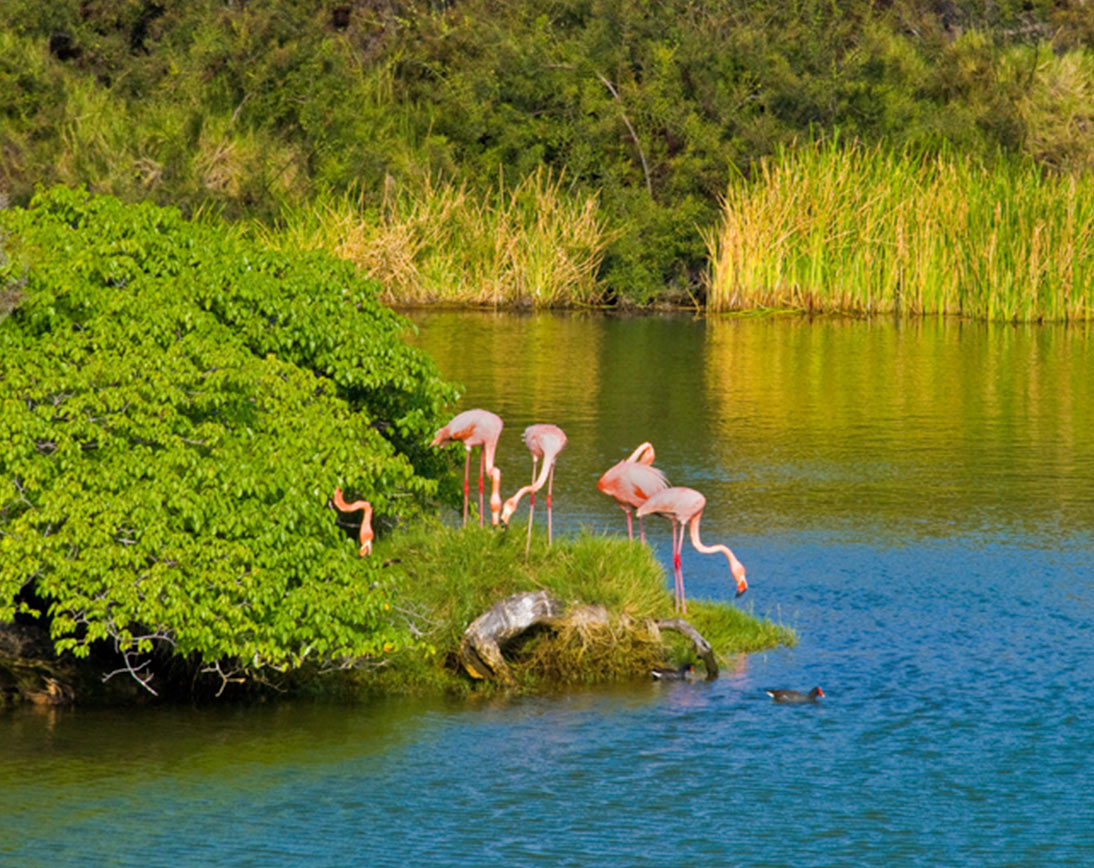
It is one of the few human populated islands of the Galapagos Archipelago. Characterized by small volcanic cones, this is one of the islands inhabited by high-stepping pink flamingos, and serves as a nesting site for marine turtles. Seasonally, this island is visited by rays and sharks. The unofficial 18th century Galapagos Islands post office has become a very unique site of the visit, where Galapagos travelers pick up and drop correspondence for their loved-ones, in a sort of traditional ritual. Galapagos Islands spectacular underwater life makes snorkeling ideal, at Corona del Diablo (the Devil’s Crown) and Champion Islands.

(Tower Islands)
Genovesa, known as Tower Island, is one of the most fascinating islands both geologically and biologically. Curiously, the chemistry of its lavas is virtually identical to lavas that erupt at mid-ocean ridges (a magma type called MORB, or mid-ocean-ridge-basalt) and quite different from most oceanic islands lavas. Genovesa is a Galapagos ornithographer’s dream. Galapagos islands nesting birds may be seen there, including masked boobies, red-footed boobies, Galapagos owls, frigates, swallow-tail gulls, lava herons, and the rare Galapagos islands lava gulls. Also to be seen there are sea lions and fur seals. The fur seal, actually a species of sea lion rather than a true seal, was nearly hunted to extinction in the Galapagos islands by the early part of the twentieth century, but has recovered.

(Albemarle Islands)
With 4588 Km2, it is the of the Galapagos Islands and is formed by a chain of five fairly young active volcanoes, one of which, Volcano Wolf is the highest point in the Galapagos Islands with 1.707 mt. At the west end of the northern arm of Isabela, we find the smaller, old Volcano Ecuador (610 mt) which comes down almost to the shore. Punta Vicente Roca, at the volcano’s base, is a rocky point with a good snorkeling area in the islands. The ship swings close to Cape Berkeley, where a large volcano half has dropped into the sea and gives an opportunity to walk through coral reefs on an uplifted ocean bed. Just south of Punta Tortuga, there is the visitor site of Tagus Cove where early sailors frequently anchored. You can still see some of the names of the vessels that visited the Galapagos Islands scratched on to the cliffs around the cove. After a dry landing, a 2 km. path will take you past a salt lagoon into the lower slopes of Volcano Darwin where volcanic formations can be observed. A panga ride along the cliffs will enable you to see various sea birds, usually including the Galapagos penguin (Speeniscus Mendiculus) and flightless cormorant (Nanopterum Harrisi). There are good snorkeling opportunities in the cove. Urbina Bay lies around the middle of the western shore of Isabela island and is a flat area formed by an uplifting that took place in 1954. Here you can find Galapagos islands corals, Galapagos flightless cormorant, pelicans and marine iguanas (Amblyrhynchus cristatus) endemic to the islands. Rays and Galapagos sea turtles can be seen in the bay. On this site, a wet landing is required to reach the trail that leads onto the corals. The view of the islands Volcano Alcedo is magnificent.
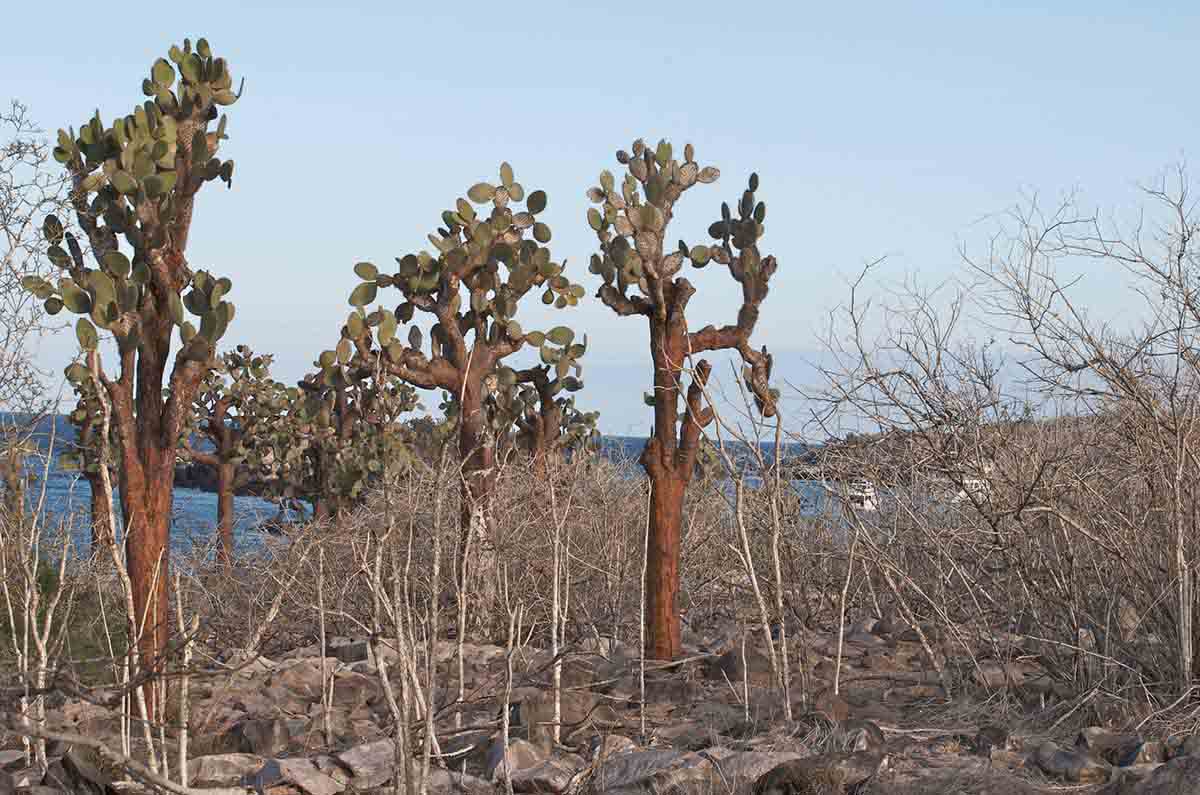
Marchena island, or Bindloe island is a large shield volcano. Marchena island, too, has lavas like Genovesa island- similar to those of mid-ocean ridge basalts. It’s an interesting geological formation.
Marchena island has had a lot of volcanic activity compare to other Galapagos Islands, though there is only one known eruption which occurred in 1992. Marchena has a caldera, like many islands in the Galapagos archipelago. Marchena’s caldera, however, has been almost completely filled with young lavas, some of which has spilled over and down the sides. The oldest lavas are 500,000 years old.
Marchena is rather desolate and has no fresh water and hence has never been settled, and its flora and fauna have not been disturbed by feral animals or introduced plants. Except for diving in the waters around it, it is off-limits to Galapagos islands tourists and is therefore seldom visited. Galapagos islands Tortoises have apparently never inhabited Marchena.

Located between North Seymour and Baltra islands is the small island of Mosquera. The island consists is a long narrow stretch of white sand, rocks, and tide pools. Created by Geological uplift the island has a flat look to it rather than the conical shape of the volcanically formed islands.
Mosquera island is a great place for visitors to wander without the typical restrictions of the other Galapagos islands. It’s ideal for snorkeling, strolling on the beach, and enjoying the animal life!
Typically, islands boat tours go to Mosquera after a stop at Baltra (to pick up passengers or drop them off).

Pinta is the third islet in the northern group of islands. Its lava is different from that of Marchena and Genovesa. The Pinta’s most famous inhabitant was Lonesome George, now in the Galapagos Islands Charles Darwin station. Due to whaling ships and buccanneers, many Galapagos tortoise populations were destroyed. The introduction of goats on Pinta was probably the straw that broke the camel’s back leaving one Galapagos Pinta tortoise (as far as we know) in this world. Galapagos Islands’s Lonesome George is the last Pinta tortoise. For years, scientists hoped to find him a mate, but alas, George is destined to life as a bachelor, and when he goes, so does his race of Galapagos Islands Pinta Tortoises. Now we are more concientious about the environment, but due to a careless past, another animal will become extinct. You can now visit Lonely George at the Charles Darwin Research station on Santa Cruz island.
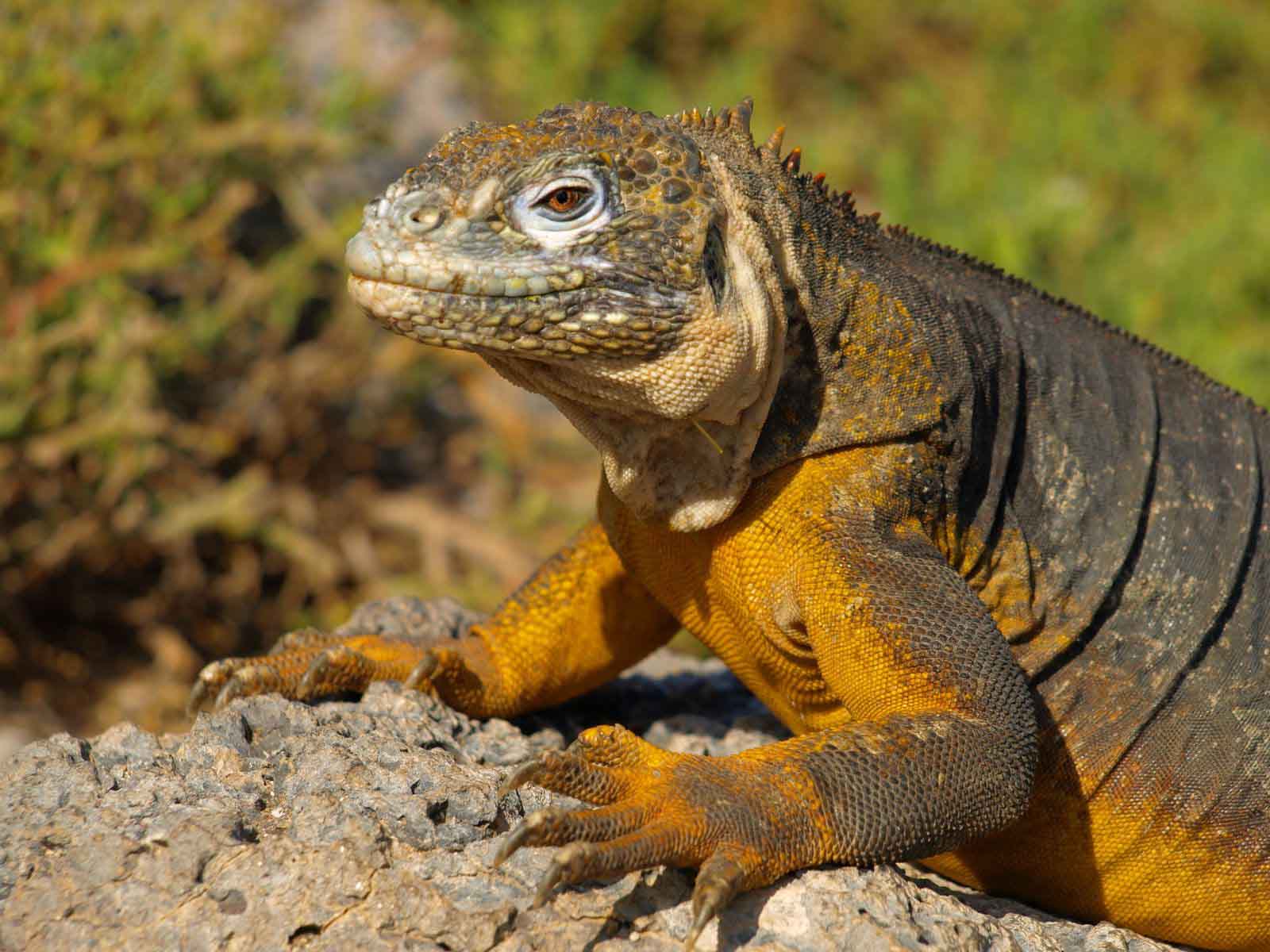
This is almost the smallest of the Galapagos islands with only 12 hectares but perhaps the most picturesque in the Galapagos islands archipelago. Visits are on the eastern part of one of two small adjoining islands uplifted from the sea through differential faulting. After a wet landing, admire an islands sea lion (Zalophus Californianus) colony waddling on the rocks, you can find land iguanas (Conolophus Subcristatus), red-billed tropic birds, colonies of blue-footed boobies, swallow-tailed gulls (Creagrus Furcatus) and a not so abundant vegetation of criptocarpus and sesuvium bushes and opuntia cacti.

(Jervis)
The area of this island is 5 Km2. and is located south of Santiago. There is a wet landing onto a dark red, sandy beach. Commonly found are sea lions and pelicans (Pelecanus Occidentalis) and behind the beach there is a salty lagoon with flamingos (Phoenicoperus Rober) and white cheeked pitails (Anas Bahamensis). Palo Santo trees and magnificent views of the islands can be found along the 750 meters of path.

(Chatman)
San Cristobal island is home of the Galapagos Islands Archipelago’s capital, Puerto Baquerizo Moreno. From here, by traveling north for an hour by boat, we can find the rocky and tiny “Isla Lobos” (sea lion islands) , which is the main sea lion and blue-footed booby colonies site for visitors to San Cristobal island. There is a 300 mts. visitors path. Also, “Punta Pitt”, is located at the northern edge of the island, and is home for one of the Galapagos Islands endemic species, the lava lizard (Tropidurus Bivittatus). Kicker Rock also known as the Galapagos islands sleeping lion is a volcanic cinder formation, where blue-footed and masked boobies can be found among frigates and other seabird species.

(Indefatigable)
This 986 km2. island is the second largest and the most populated of the Galapagos Islands Archipelago. Puerto Ayora is the main town on the southern coast of the Galapagos Islands . A 20 min. walk, northeast by road leads you to the Charles Darwin Research Station, which is one of our visitor sites and the main center of research and conservation of the Galapagos Islands species, especially the 11 surviving species of Galapagos Islands tortoise (Geochelone Elefanthopus). The other site, The Highlands, is located about 12 km. from Bellavista. En route you pass from the xerophitic vegetation into the Scalecia, Miconia, Fern-sedge areas as well as Opuntia and the Cereus, Palo Santo, Croton and Cryptocarpus bushes.
This visit includes a hike around “Los Gemelos”(The Twins), which are sink holes rather than craters, and are surrounded by Scalecia Forest, where a great number of birds like the Vermillion Flycatcher (Myarchus Magnirostris) and the famous Darwin’s Finches (13 species) are to be found. Finally, other interesting places are the “Lava Tubes” which are underground tunnels of over a km in length, formed by the solidification of the lava flow, and “Las Bachas” beach which is commonly deserted and is a good place for sunbathing and swimming.

Here, if you keep your eyes open and are lucky, you’ll see the Galapagos Islands Santa Fe land iguana, found nowhere else in the world. It’s an arduous trek to the highlands, but well worth it. The Santa Fe Islands land iguanas aren’t nearly as colorful as the iguanas on Plazas Islands, but they’re big and fun to watch.
This is also a great place for snorkeling. The Galapagos Islands waters in the cove are a radiant green, and here you can see sea turtles gracefully swimming by. There’s also a big colony of sea lions – something you’ll never tire of seeing in the Galapagos Islands.

(San Salvador Island -James Island)
On the western side of this 585 km2 island, on James Bay you find Puerto Egas: a long black lava shoreline where the eroded shapes form lava pools, caves and inlets housing a great variety of Galapagos Islands wildlife. This is a great place to see the Galapagos Islands marine iguanas basking in the sun, and pools are full of red sally light-foot crabs which attract hunting herons (Butorides Sundevalli). James Bay has excellent snorkeling sites where moray eels, Galapagos sharks and octopus may be found.
Behind the shoreline is Sugar Loaf volcano, and on the path you can find lava lizards (Tropidurus Albermarlensis), Darwin finches, doves and the Galapagos hawk (Buteo Galaparnsis). Here, the most common species of vegetation is the scalesias.

There is abundant life around the 1 1/4 km. visitor’s path. On this island you can find sea lions (Zalophus Californianus) waddling on the beach, land iguanas (Conolophus Subcristatus), frigate birds displaying their red pouches, colonies of blue-footed boobies, swallow-tailed gulls (Creagrus Furcatus), the bright yellow warbler (Dendroica Petechia), as well as fur seals.
To cruise the Galapagos Islands on board a yacht allows for a very intimate and more personal cruise experience. A smaller group of cruise travellers allows for a closer encounter with nature, being your cruise of the Galapagos more relaxed and in depth. Your Galapagos excursions will be in small groups of 10 – 16 people. A yacht cruise has more flexibility and brings passengers to special visitor sites where only a small yacth is allowed to reach. For those looking for a longer cruise only yachts sail with itineraries longer than a week and cruise ships no larger than 40 passenger capacity are allowed to change their itinerary and visit special interest sites.
In the Galapagos Islands there are several deluxe cruise yachts and small ships.
There are no formal categorizations and many Galapagos cruise operators and yacht owners will advertise themselves as deluxe, if you are acquainted with international standards you will notice that this is not true. We have rated and are constantly inspecting the yachts in the Galapagos Islands under the following cruise category standards.
This designation is assigned to those Galapagos cruise yachts with air conditioning, spacious social areas(dining room, living room, sun decks), double oceanview cabins with private facilities and hot water, also yacht decoration and furnishings on board are on the elegant side. We have also taken into account the yacht construction, maintainance of facilities, safety standards and procedures which meet the highest international cruise standards.
Food on board these Galapagos cruise yachts is of high quality and usually is prepared by a chef and arrangements can be made to meet special dietary needs. You will also have a highly trained yacht crew, a Galapagos category A naturalist guide(University degree or equivalent in experience) that speeks a high level of English and other foreign languages. Excellent cruise itinerary.
Galapagos cruise yachts under this category have air conditioning, moderately spacious social areas(dining room, living room, sun decks), double oceanview cabins with private facilities (in most cases hot water). Yacht construction, maintainance of facilities, safety standards and procedures meet international cruise standards.
Food on board these Galapagos cruise yachts is of good quality and arrangements can be made to meet special dietary needs. You will also have a highly trained yacht crew, a category A Galapagos naturalist(University degree or equivalent in exprience) or a category B Galapagos National Park certified guide(has a good knowledge of the Galapagos Islands) that speeks a high level of English and other foreign languages. Excellent cruise itinerary.
Galapagos cruise Yacht under this category have air conditioning(may not be fully functional), moderately spacious social areas(dining room, living room, sun decks), double cabins with private facilities (sometimes hot water). Yacht construction, maintainance of facilities, safety standards and procedures usually meet international cruise standards.
Food on board these Galapagos cruise yachts is of good quality and arrangements can be made to meet special dietary needs. You will also have a highly trained yacht crew, a category A or B Galapagos National Park certified guide(has a good knowledge of the Galapagos Islands) that speeks a good level of English and other foreign languages. Good cruise itinerary.
Galapagos cruise Yacht under this category may or may not have air conditioning(may not be fully functional), small social areas(dining room, living room, sun decks), double and triple cabins some with private or shared facilities (sometimes hot water). Yacht construction, maintenance of facilities, safety standards and procedures in most cases do not meet international cruise standards.
Food on board these Galapagos cruise yachts is of average quality. Yacht crew is not as well trained as on board higher category Galapagos cruise yachts, You will have a category B Galapagos National Park certified guide(has a good knowledge of the Galapagos Islands and speeks a good level of English and other foreign languages) or a category C certified Galapagos National Park guide(average knowledge of the Galapagos Islands and a poor level of English). Descent cruise itinerary.
The Galapagos Islands wildlife is special and in many cases found nowhere else. There are wildlife species that are endemic to 1 or 2 islands. Wildlife friendlier than at other places around the globe and do not fear being approached, due to the lack of human predation, this gives the Galapagos wildlife an enchantment and grace to be admired. The Galapagos is a wildlife sanctuary and protects many species from extinction, wildlife roams stress free and continues its path towards evolution.
Below is a list of the wildlife inventory for the Galapagos and the island on which each species may be found.
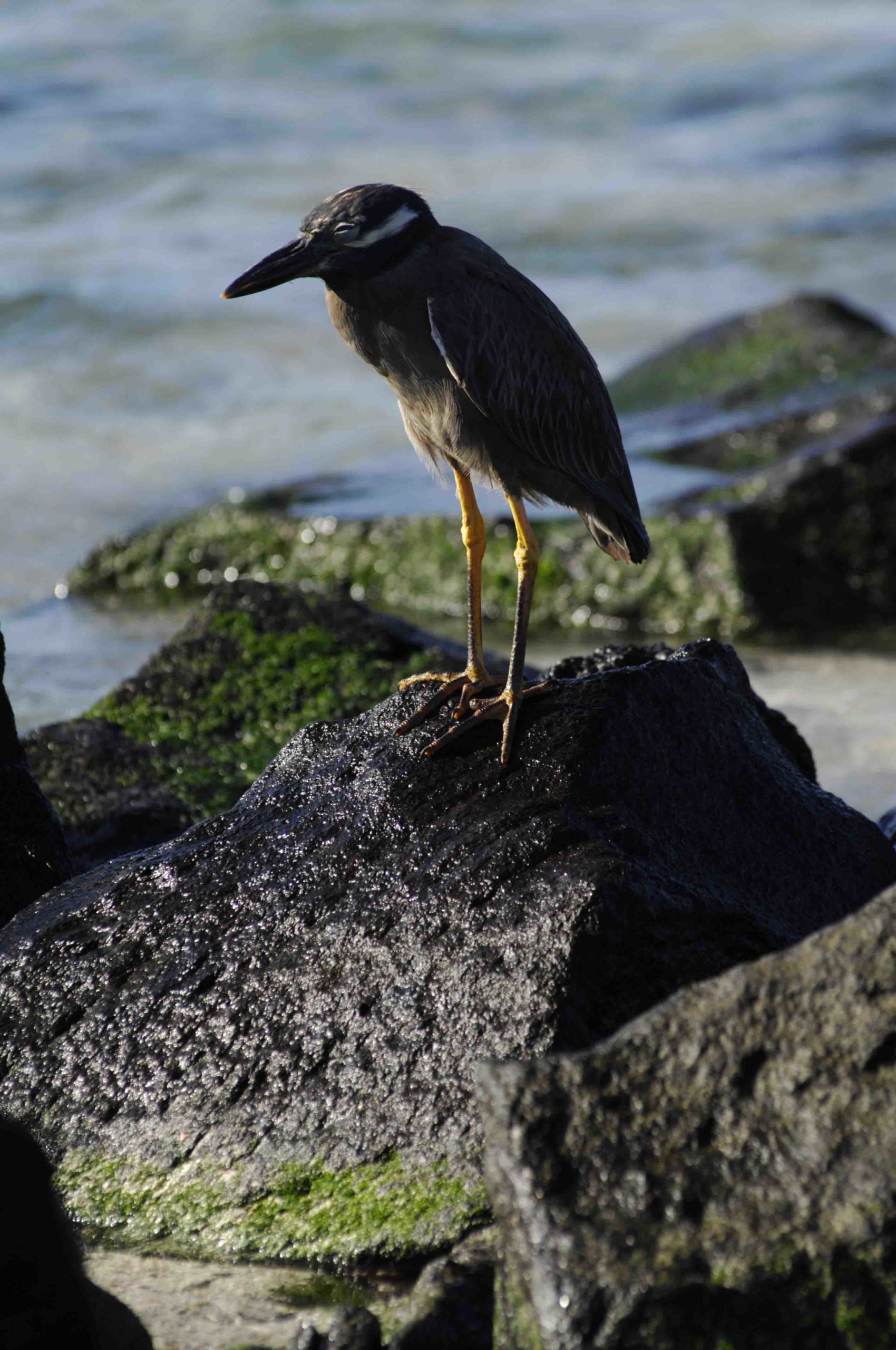


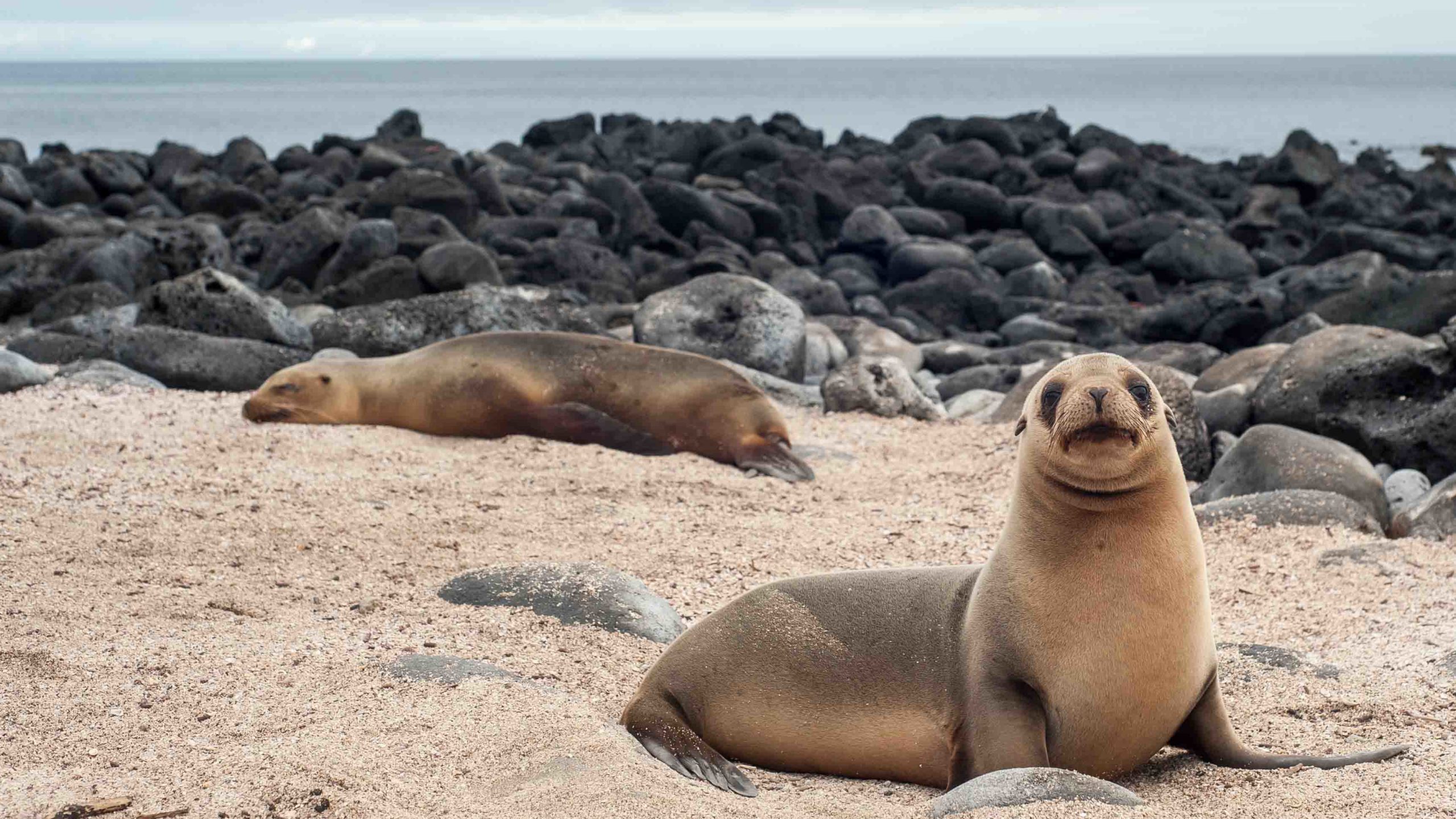


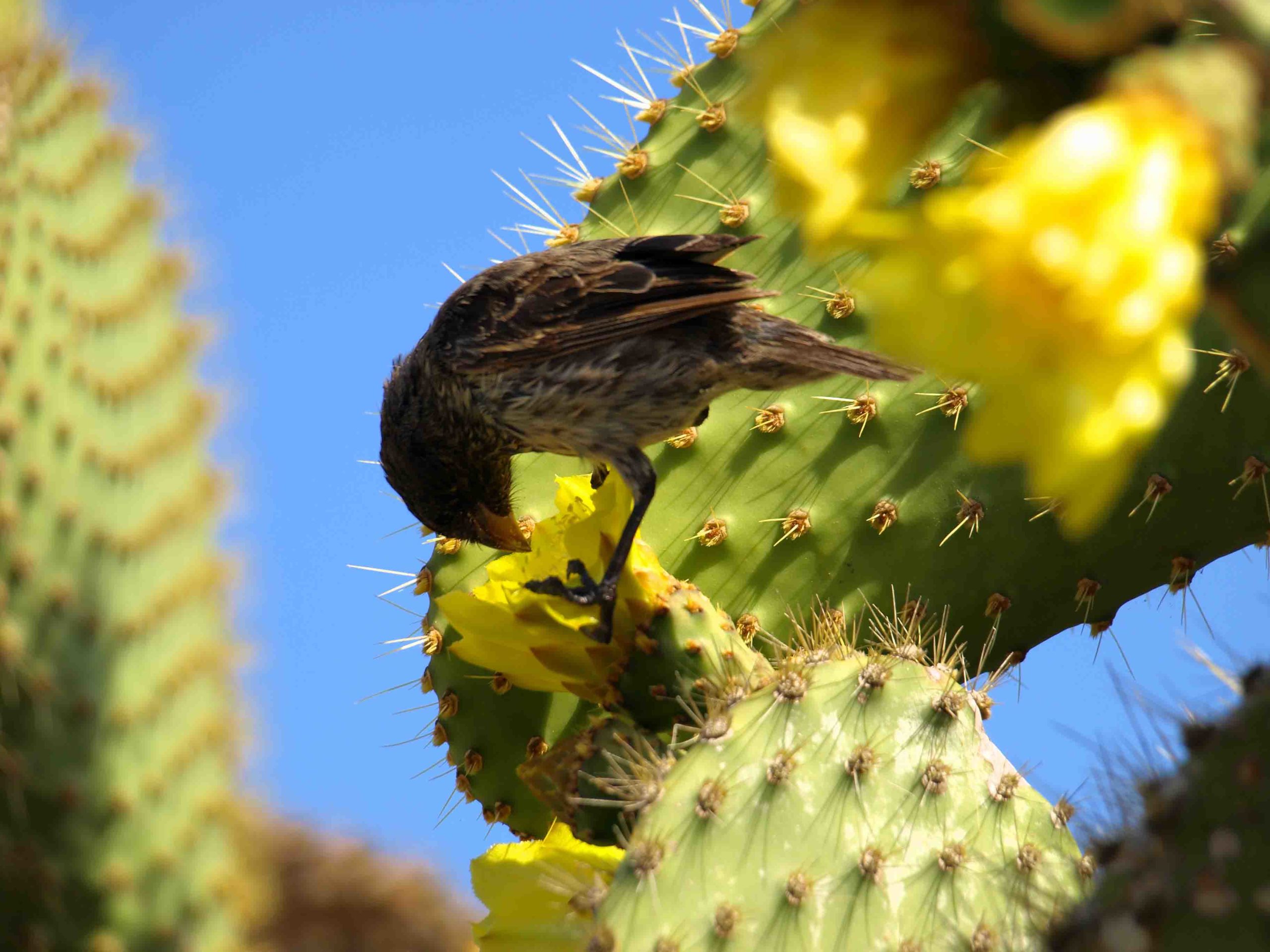
The Famous Finches (Fringillidae): What would the Galapagos wildlife be without Darwin’s finches? Keep your eyes open because they are found everywhere and might even eat right out of your hand! There are 13 endemic species differentiated by the size and form of their beaks.